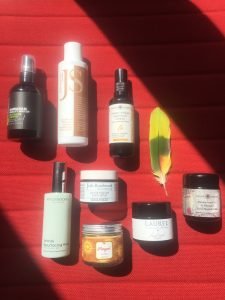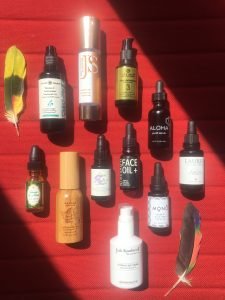In my previous blog post, I wrote about how I have accepted having melasma and how they always remind me of my wilder young years. Being wild has not changed much, I must say! Now is time to talk about my journey on how to keep it under control and prevent any further sun damage.
There are plenty of ways to treat melasma from topical creams / serums to laser treatments to chemical peels. Before you choose how to go about it, you must understand what caused it. The main triggers known is partly by sun, genetic predisposition, and hormonal changes (think about pregnancy, birth control pills).
There are many advantages or disadvantages for each of the treatments, I will focus on my particular choice. I highly recommend you discuss either with your esthetician or your Dermatologist the treatment that is most suitable for you.
When first diagnosed, I was prescribed a topical cream containing Hydroquinone, it is skin lightener used in many whitening creams and dark marks fade treatments. It reduces the production of melanin in your skin, meaning that is greatly used for fading hyper pigmentation, acne marks, sun spots, melasma, and other skin discoloration issues.
Despite Hydroquinone being prescribed to me, I decided not to use it after doing an evaluation of pros and cons (same for lasers and chemicals treatments too). Since it inhibits melanin production to help lighten skin, in the long term it can damage your pigment cells, it makes your skin more sensitive to the sun, it can cause redness, irritation, and contact dermatitis. All in all, not a risk I was willing to take.
My approach towards it is to prevent more damage and maintain the affected area as healthy as possible, it might have a mind of its own. Ingredients / products I have chosen are meant to either prevent or help reduce the dark spots. Keep in mind that during summer months my melasma might be more pronounced than during the winter time due to the nature of my skintone.
Here are my personal golden rules. I’m not an skincare expert but I do consider myself an expert when it comes to my own skin, only you can tell how your skin condition is on a daily basis and your esthetician if you visit one on regularly. The regimen should cover some of the basics: a gentle but effective exfoliator, antioxidants combination and sunscreen.
Disclaimer: the products shown on the following photos are my own personal choices, this is not a PR post in any way. The products used are all strictly based in my own personal experience. It’s simply for the purpose of giving you examples of what you can look for.
Exfoliation
For exfoliation, AHAs (alpha hydroxy acids work on the surface) and BHAs (beta hydroxy acids work deeper) both types provide the benefit of: decreasing inflammation and appearance of large pores and surface wrinkles, remove dead skin cells, even out skin tone, unclog pores and improve skin texture. You can use an exfoliating toner or an exfoliating mask depending on your skin type and the acids you can tolerate. Consider Glycolic and Lactic acid the most known AHAs; Salicylic acid an example of BHA. There are other less know on acids that are helpful to treat melasma, as well as hundreds of products out there to choose from, finding the right one for your skin is can be a challenge. Golden rule: start slow (once or twice a week) and built it up, your skin is your compass. Always when using acids be aware that your skin might become photosensitive, you have to be religious with using daily SPF.
Hydration and Antioxidation
Since the skin affected by melasma is already damaged, you need to consider that it might require extra care. I find the area to have a tendency to be dry, to help skin to retain its moisture a Hyaluronic acid serum is a great option. Hyaluronic acid is naturally produced by our body, however as we age the production decreases; and I can use all the help I can! Aloe Vera is another great humectant which is why so popularly used in skincare. Others to mention a few are glycerin, seaweed, algaes, etc. The point I am trying to make is to add into your routine products that will help lock the moisture to the epidermis.
Prevention
SPF 30 minimum – 365 days a year non negotiable. Wearing a daily sunscreen is essential. Yes, it is a pain in the bum to find one that works for you but once you do, you will never be without it; you will apply it without even thinking. Make sure the sunscreen you choose does not irritate your skin or melasma as it might make it worse. I cannot emphasize enough how important SPF is, it will not only prevent more melasma or hyperpigmentation of appearing but also delaying the appearance of fine lines. Wear it even when you don’t think you will need it, I rather be safe than sorry!
Vitamin C serums – Vitamin C is is quite key for skin health as it helps in collagen synthesis which keeps our skin firm and resilient, protecting it from wrinkling. Vitamin C may help prevent and treat ultraviolet induced sun damage. There are many forms of Vitamin C some stable some not, but that’s not the point of this post. I have found Vitamin C serums to help brighten the overall skin tone and prevent the melasma from getting any darker.
Extra boosters
Adding Serums specifically formulated to help treat melasma, hyperpigmentation or scars are certainly a great thing to do on top of your usual routine. It will help enhance the effect of your other products giving the extra oomph. Look for ingredients like Rosehip oil, Sea Buckthorn oil, Tamanu oil, Prickly Pear Seed Oil Turmeric, Pomegranate, Green tea, Licorice and so many more.
Masks with brightening properties are also a fantastic addition to your skincare regimen for treating melasma or other skin concerns, they are simply fantastic extra boosters to feed your skin.
All of the products I use are helping tremendously to keep at bay the dark spots, my personal choice is to go for non aggressive treatments and keep an overall healthy looking skin.
Be happy with your own skin, care for it and be proud of your imperfections, after all is all about loving yourself as you are.
Xx
P.S. Any questions, please don’t hesitate to ask!











Very informative post that I think anybody could benefit from — not just those with melasma. I’m glad you’re not using HQ, though I don’t think it’s bad if it works for someone — as you say, only you can know what’s right for you.
That water/beach shot is out of this world. Almost unreal!
Thanks Robin! I think HQ can work but I did not want to risk it, long term use is the problem it. Once you understand your skin, it makes it so much easier to have the correct products right?
Glad you like the photos, they are taken in Sardinia, specifically Tahiti Beach – love that place Xx
Hi, this is a great post Adri, I could not agree more with you. I have my dark spots, which are due to sun sensitivity after topical antibiotics around 20 years now and I see that after all these years. I’ve given up the fight long time ago and just want to keep them at the same level. My routine because of the dark spots is almost the same as yours, but I put two or three layers of SPF, afraid that I’ll miss a place without any SPF.
Great post! I agree with your philosophy, hydroquinone is too controversial. I’m glad you are using Vitamin C, it’s a great ally for pigmentation. Summer is just not a good time to try to lighten. Good luck!
Thanks Pam! Way too controversial, I agree! Indeed, Vitamin C is a great ally for our skin, I like how you called it! Happy Friday beautiful Xx